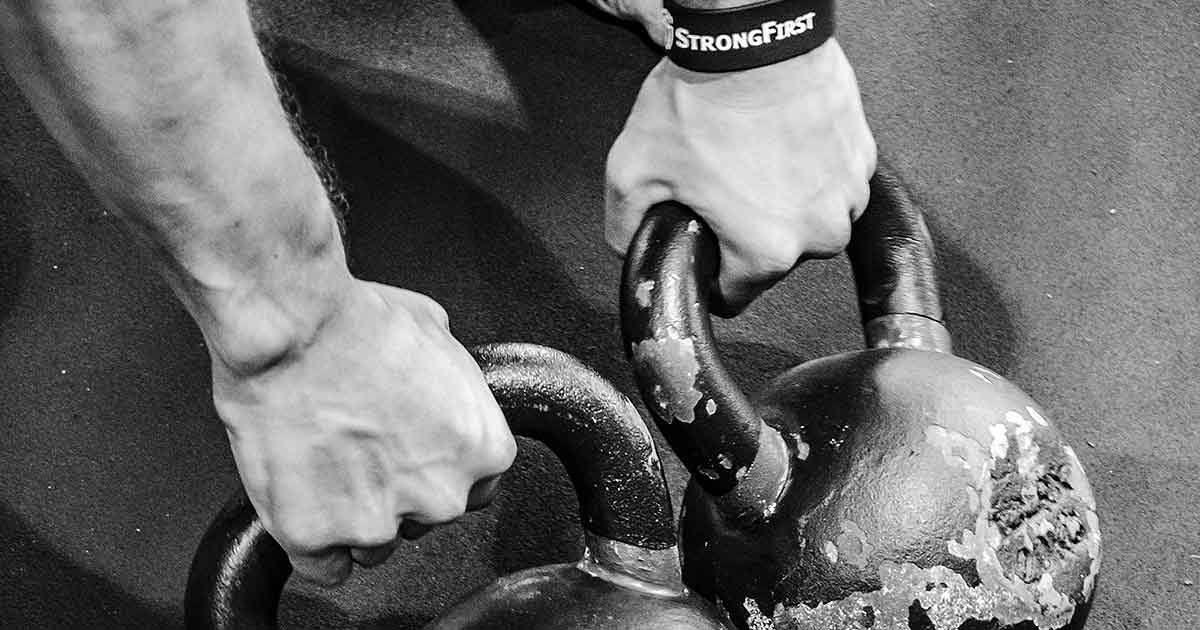In this classic article, Dan John proposes a certain path through the StrongFirst KB universe
We should use performance standards to dictate when new skills are introduced. Follow the path laid out by Pavel. Let’s take a look at how this works.
www.strongfirst.com
- Patterning of TGUs, Swings and Goblet Squats
- Simple & Sinister to Simple (maybe Timeless Simple only)
- ROP to 1/2 BW press and Snatch Test
- Attacking Solid/Sinister
- Double Bells: e.g., Total Tension Complex
I think this makes a lot of sense. Some might argue that double bells could be introduced earlier. However, with some new programs out there, there are even more options. In my mind, it lays out like this:
Phase 1: Building a base (and a basic house on top of it)
Beginner to intermediate
With a single set of 16, 24, and 32 kg a gentleman could go this route:
- Swings and Getups to at least 40% of Bodyweight (or Simple goals)
- Timeless Simple OR
- BJJ Fanatics Plan (Strong Endurance)
- Clean and Jerk to 40% of bodyweight with a single bell (BJJ Fanatics Plan A and B)
- ROP, at least to a 32 kg press and 24 kg snatch test for males
- Specializing a little in the C&P or the Snatch
- The Giant, working up to doing it with a single 32 kg
- Q&D 044 or A+A Snatches
I guess for ladies the same could apply, probably with bells from 8 to 24 kg in 4 kg jumps.
Obviously, you would need to learn the following moves before embarking on any of the plans:
- Swings, Get-ups, Goblet Squats
- Clean and Jerk (with Push Press and Long Push Press in the progression)
- Clean and Press, Snatch
--
Phase 2: Specialization: Strength and/or StrongEndurance
Intermediate to advanced
After phase 1 (which could last years) one would need some heavier bells, double bells - or a barbell.
The options are manifold: You could introduce doubles with one of the following plans:
Or you could spezialize in StrongEndurance plans like
- Q&D with either Swings + Pushups (or Viking Push Press), or Snatches
- C&J as doubles or singles according to the BJJ Fanatics plan
- Simple and Sinister to Timed Simple - and/or to Solid or Sinister
- BJJ Fanatics Swings & Getups plan (A+A style)
Somewhere along the way could probably also introduce Strength Aerobics for a while (standalone) or as an add-on to Simple and Sinister. Same with Naked Warrior. And of course you could start a Barbell Journey, probably starting with PTTP,
Vodka & Pickles or
Daily Dose Deadlift.
Somewhere along the road one could settle for 2-3 plans to rotate, like A+A, S&S, Q&D, PTTP
Occasionally one could go for variety, for example with ETK+ or Total Package Template. Or one could try a peaking plan, for example for the TSC or for hypertrophy. Of course there are a lot of other plans for the decades ahead by Geoff Neupert, Fabio Zonin, and others. I am actually looking forward to more options coming out in the future (Strength Aerobics by
@Brett Jones for example, or ROP 2.0).
--
Just wanted ot put it out there. If you have any suggestions or see it differently, I am happy to hear your thoughts. Personally I am still at Phase 1/Point 1 and will probably switch to the BJJ Fanatics plans over the course of the year.

